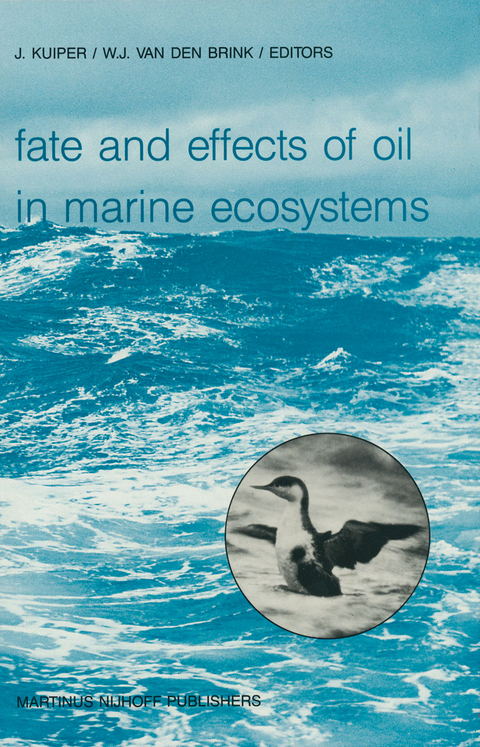
Fate and Effects of Oil in Marine Ecosystems
Springer (Verlag)
978-94-010-8098-9 (ISBN)
I. “Physical and chemical behaviour of oil in the marine environment and biological processes affecting the fate of oil in marine ecosystems”.- The physical fate of weathered crude and emulsified fuel oils as a function of intertidal sedimentology.- Weathering of mineral oil in marine environment.- Droplet size distribution of naturally dispersed oil.- Hydrocarbon biodegradation in marine sediments: a biochemical approach.- A simple remote sensing system for the determination of dispersants effectiveness.- Biodegradation and photo-oxidation of crude oils in a tropical marine environment.- Oil in sediments of the Humber estuary following the ‘Sivand’ oilspill incident.- Laboratory and field investigation of the accumulation and depuration of petroleum hydrocarbons by black mussels.- II. “Effects of oil on species, populations and ecosystems, both in laboratory tests and in the field (including model ecosystems) and effects of the treatment of oil spills”.- The effect of the water soluble fraction of North Sea crude oil on the transport mechanism of taurine in erythrocytes from flounder, Platichthys flesus (L.).- Assessment of the vulnerability of marine mammals to oil pollution.- Effects of different oil doses, dispersant and dispersed oil on macrofauna in model tidal flat ecosystems.- Experimental application of oil-based muds and cuttings to seabed sediments.- Petroleum effects on osmoregulation in the marine halophytes Spartina alterniflora and Rhizophora mangle.- Oil pollution and plankton dynamics. IV. Summary of enclosure experiments in Lindåspollene, Norway, with special emphasis on the balance between autotrophic and heterotrophic processes.- The effects of oil and chemically dispersed oil on natural phytoplankton communities.- Oil and the mangrovesof the northern Red Sea.- Effects of seven dispersants on growth of three subtropical/tropical atlantic seagrasses.- Toxicity of chemically dispersed oil in a flow-through system.- The use of tests in a wave basin to define dispersant effectiveness.- An assessment of the environmental hazard associated with the discharge of production water from a North Sea oil platform based on laboratory bioassays with a calanoid copepod - Acartia tonsa (Dana).- The effectiveness of a new type III dispersant in the treatment of weathered crude and emulsified fuel oils on saltmarshes and sandflats.- Impact of oil on coastal industries.- The effects of oil pollution on interacting salt marsh species.- III. “Monitoring of oil in abiotic compartments of marine ecosystems and monitoring of biological effects of oil spills both on the species and the ecosystem level”.- The migration of stranded oil from a sheltered beach into adjacent nearshore subtidal sediments.- Kinetics of aromatic hydrocarbon depuration by oysters impacted by the AMOCO CADIZ oil spill.- Biological and chemical monitoring of seabed sediments at the Sullom Voe North Sea terminal - a synthesis of data for the period 1978-1985.- Measurement of scope for growth and tissue hydrocarbon concentrations of mussels (Mytilus edulis) at sites in the vicinity of the Sullom Voe oil terminal - a case study.- Oil-based drilling fluids: are they an environmental risk?.- Practical methods for monitoring rocky shore communities.- A summary of research and monitoring studies carried out in North Sea oilfields by the Oil Pollution Research Unit 1973-1986.- IV. “Risk management and risk analysis”.- SEABEL Hazard identification and response decision for chemical spillages at sea.- Oil spill risk management: the strategic responsecase.- Environmental impact assessment procedure for oil pollution in the Dutch Wadden Sea - the F3 pipeline example.- International acceptance of shoreline sensitivity mapping as an integral spill-response component.- A computer simulation model depicting oil impact and removal within coastal environments.- The Alvenus oil spill along the Texas coastline.- Keyword index.- Scientific names of organisms mentioned in the texts.
| Zusatzinfo | XIII, 338 p. |
|---|---|
| Verlagsort | Dordrecht |
| Sprache | englisch |
| Maße | 155 x 235 mm |
| Themenwelt | Naturwissenschaften ► Biologie ► Limnologie / Meeresbiologie |
| Naturwissenschaften ► Biologie ► Ökologie / Naturschutz | |
| ISBN-10 | 94-010-8098-4 / 9401080984 |
| ISBN-13 | 978-94-010-8098-9 / 9789401080989 |
| Zustand | Neuware |
| Haben Sie eine Frage zum Produkt? |
aus dem Bereich


